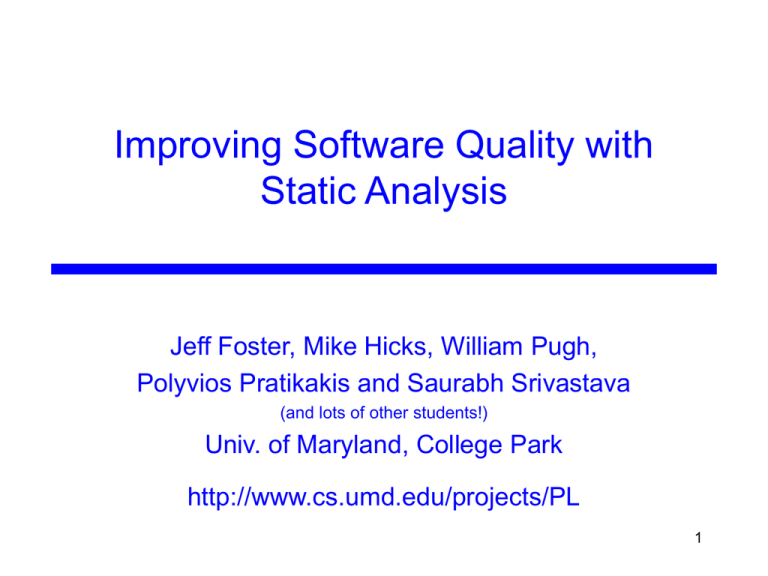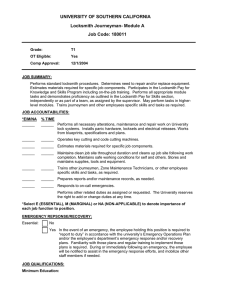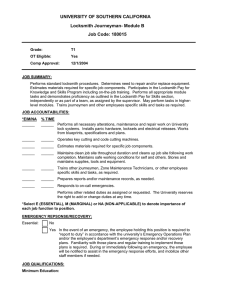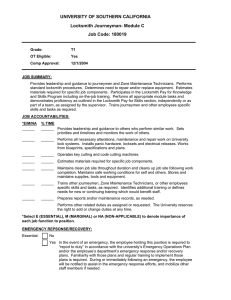Improving Software Quality with Static Analysis
advertisement

Improving Software Quality with
Static Analysis
Jeff Foster, Mike Hicks, William Pugh,
Polyvios Pratikakis and Saurabh Srivastava
(and lots of other students!)
Univ. of Maryland, College Park
http://www.cs.umd.edu/projects/PL
1
Students
•
•
•
•
•
•
•
•
•
•
•
•
Nat Ayewah
Brian Corcoran
Mike Furr
David Greenfieldboyce
Chris Hayden
Gary Jackson
Iulian Neamtiu
Nick L. Petroni, Jr.
Polyvios Pratikakis
Saurabh Srivastava
Nikhil Swamy
Octavian Udrea
QuickTime™ and a
TIFF (Uncompressed) decompressor
are needed to see this picture.
2
Approach to Building Useful Tools
• Scope
– What properties are of interest?
• Technique
– Bug finding or verification?
– How to balance efficiency, utility, and precision?
• Evaluation
– How to show that tools are actually useful?
3
Approach Applied
• Scope
– We focus on tools that can be used to improve
reliability and security of software
• Technique
– We run the gamut from unsound to sound, from
simple to precise
• Evaluation
– We empirically validate our tools on available,
industrial-strength software development efforts
4
Open Source
• We release all of our tools
• Allows and encourages real industrial involvement and
feedback
• Allows academic community to learn from and build on
our work
5
University of Maryland
• Our department also has a number of faculty in software
engineering and human computer interaction
– The division between SE and PL is fuzzy, artificial
and not particularly significant
• This encourages and facilitates our efforts to look at how
software development is practiced in the world today
6
This Presentation
• An overview of four tools we have developed
– FindBugs - a tool for finding bugs in Java programs
– Locksmith - a sound* tool for verifying the absence of
races in C programs
– CMod - a backward-compatible module system for C
– Pistachio - a mostly-sound tool for verifying network
protocol implementations
• Some retrospective thoughts
• Looking ahead
* rather, as sound as is reasonable for C
7
FindBugs
•
•
•
•
An accidental research project
Over 407,860 downloads
Used by many major financial firms and tech companies
Turns out that lots of stupid errors exist in production
code and can be found using simple techniques
– but successfully using this in the software
development process can be a challenge
• An agile effort
– do just want is needed to be useful in finding bugs
– be driven by real bugs and real customers
FindBugs
8
Linus Torvalds
Nobody should start to undertake a large project. You start
with a small, trivial project, and you should never expect
it to get large. If you do, you'll just overdesign and
generally think it is more important than it likely is at that
stage. Or, worse, you might get scared away by the
sheer size of the work you envision. So start small and
think about the details. Don't think about some big
picture and fancy design. If it doesn't solve some fairly
immediate need, it's almost certainly overdesigned.
FindBugs
9
Cities with Most Downloads This Year
FindBugs
10
QuickTime™ and a
TIFF (Uncompressed) decompressor
are needed to see this picture.
FindBugs
11
Working with Companies
• Working with Fortify Software and SureLogic as
sponsors
• Visiting lots of companies that are using FindBugs
– working in depth with a few of them
• Gaining appreciation for lots of issues
– including many that never come up at PLDI/PASTE
FindBugs
12
Locksmith: Data Race Detection for C
• Multi-core chips are here
– Induced by the hardware frequency & power walls
– Already, Intel published 80-core prototype
• But multithreaded software is
– More complicated, difficult to reason about, difficult to
debug, difficult to test
• Data races are particularly important
– Can we build a tool to detect them automatically?
Locksmith
13
Why Data Races?
• Data races can cause major problems
– 2003 Northeastern US blackout
• Partially due to data race in a C++ program
– http://www.securityfocus.com/news/8412
– Therac-25 medical accelerator
• Data race caused some patients to receive lethal
doses of radiation
• Data races complicate program semantics
– Meaning of programs with races often undefined
• Race freedom underpins other useful properties, like
atomicity
Locksmith
14
Programming Against Data Races
• x ~ l (“x is correlated with lock l”)
– Means that l is held during some access to x, e.g:
lock(&l);
x = 4;
unlock(&l);
• x and l are consistently correlated if x is always
correlated with l
– I.e., l is always held when x is accessed
– I.e., x is guarded-by l
• If all shared variables are consistently correlated, then
the program is race-free
Locksmith
15
Locksmith: Data Race Detection for C
[PLDI 06]
• Detect races in programs that use locks to synchronize
– Note: there are other ways to synchronize than locks, but locks are:
• Widely used
• Easy to understand and program
• We want to be sound
– If Locksmith reports no races, then there are no races
• Locksmith at a glance:
– At each dereference, correlate pointer with acquired locks
– For every shared pointer, intersect acquired locksets of all
dereferences
– Verify that each shared pointer is protected consistently
Locksmith
16
Example
void foo(pthread_mutex_t *l, int *p) {
pthread_mutex_lock(l);
*p = 3;
pthread_mutex_unlock(l);
}
pthread_mutex_t L1 = ...;
int x;
foo(&L1, &x);
x
L1
*p
*l
Static analysis representation:
Graph representing “flow” and
correlation
Locksmith
17
Example
void foo(pthread_mutex_t *l, int *p) {
pthread_mutex_lock(l);
*p = 3;
pthread_mutex_unlock(l);
}
pthread_mutex_t L1 = ...;
int x;
foo(&L1, &x);
x
L1
*p
*l
Actuals “flow” to
formals
Locksmith
18
Example
void foo(pthread_mutex_t *l, int *p) {
pthread_mutex_lock(l);
*p = 3;
*p accessed with *l held
pthread_mutex_unlock(l);
}
pthread_mutex_t L1 = ...;
int x;
foo(&L1, &x);
x
L1
*p
*l
~
Locksmith
19
Example
void foo(pthread_mutex_t *l, int *p) {
pthread_mutex_lock(l);
*p = 3;
pthread_mutex_unlock(l);
When we solve the graph,
}
we infer x accessed with L held
pthread_mutex_t L1 = ...;
int x;
foo(&L1, &x);
x
L1
~
*p
*l
~
Locksmith
20
Challenges
• Context-sensitivity for function calls
– Suppose we call foo(&x, &L) and foo(&y, &M)
– Want to know x ~ L and y ~ M exactly
• If we thought x accessed with M held, would report false race
• Flow-sensitivity for locks
– Need to compute what locks held at each point
– Can acquire and release a lock at any time (even in different
functions)
• Need to worry about type casts, void*, inline asm(), etc.
– Conservative analysis necessary for soundness
– …without sacrificing precision
• Need to determine shared locations
– No need to hold locks for thread-local data
Locksmith
21
Locksmith Results
• Locksmith addresses these challenges
– Usually, no annotations required from the
programmer
• Few annotations if locks are in data structures
– As sound as is reasonable for C
– Still small number of warnings
• Evaluation
– Standalone POSIX thread programs
– Linux device drivers
• Wrote small model of kernel that creates two
threads and calls device driver in various ways
Locksmith
22
Evaluation
• Experiments on a dual core Xeon processor, 2.8MHz,
with 4GB memory
• Three counts, each per shared location
– Warnings: number of locations x reported to be in a
data race
– Unguarded: number of shared locations sometimes
accessed without a lock
• Not all are races–some programs used
semaphores to protect shared locations
– Races: actual data races
Locksmith
23
Experiments
QuickTime™ and a
TIFF (LZW) decompressor
are needed to see this picture.
Locksmith
24
Summary
• Locksmith was able to find data races automatically
– Some of the races are benign, several can cause the
program to misbehave
• Relatively low false positive rate
– Most false positives are due to conservative handling
of aliasing and C type casts
• Formalized and proved correct key parts of the system
– Basic race detection framework (correlation)
– Locks in data structures
Locksmith
25
CMod: A module system for C [TLDI 07]
• Module Systems:
– Information Hiding
pub
• Symbols and types
priv
priv
pub
• Multiple implementations
– Type Safe Linking
s : t1-> t2
s : t1-> t2
• Separate compilation
• Modules in C?
– Physical modules:
• .c files as implementations; .h as interfaces
– Documented? - No.
– Practiced? - Yes.
B
A
B
A
CMod
26
The Objective
• Enforce information hiding and type-safe linking in C
• Convention
– .h files as interfaces
– .c files as implementations
• The problem
– Convention not enforced by compiler/linker
– Basic pattern not sufficient for properties
• CMod: A set of four rules
– Overlay on the compiler/linker
– Properties of modular programming formally
provable
CMod
27
Violating Modularity Properties
Provider
bitmap.h:
Client
main.c:
struct BM;
#include “bitmap.h”
void init(struct BM *);
void set(struct BM *, int);
Accessing Private Functions
bitmap.c:
Interface--Implementation
#include “bitmap.h”
disconnect
extern void privatefn(void);
int main(void) {
struct BM *bitmap;
struct BM { int *data; };
init ( bitmap );
set ( bitmap , 1 );
… main(void) {
int
} struct BM *bitmap;
struct BM { int data; };
void init(struct BM *map,
*map) {
int
… }
val) { … }
init ( bitmap );
set ( bitmap , 1 );
privatefn();
void set(struct BM *map, int bit) { … }
bitmap.data = …
void privatefn(void) { … }
…
Violating Type Abstraction }
CMod
information hiding
Bottom-line: Compiler happy, but type-safe linking not guaranteed
28
Example Rule; Rule1: Shared Headers
Whenever one file links to a symbol defined by another file, both must
include a header that declares the symbol.
• Prevents bad instances
• Flexible:
– Multiple .c files may share a single .h header
• Useful for libraries
– Multiple .h headers for a single .c file
• Facilitates multiple views
• Provider includes all; clients include relevant
view
CMod
29
Rule 1:
Shared Headers
symbols
type
preprocessor
interaction
???
Rule 2:
Type Ownership
CMod
30
Preprocessor configuration
Its important that
both files be compiled
with the same -D flags
Provider switches
between two versions
of the implementation
depending on the flag
COMPACT
The order of these
includes is important
CMod
31
Consistent Interpretation
• Consistent Interpretation
– A header is included in multiple locations
– Should preprocess to the same output everywhere
• Causes of inconsistent interpretation:
– Order of includes
Rule 3
– Compilation with differing -D flags
Rule 4
CMod
32
Rules 1,2
gcc
symbols
type safety + inf hiding?
Rules 3,4
type
preprocessor
interaction
•
•
System sound?
Does it work in practice?
gcc
type safety + inf hiding? no
CMod
33
CMod Properties
• Formal language
• Small step operational semantics for CPP
• If a program passes CMod’s tests and compiles and
links, then
Information Hiding
– Global Variable Hiding
– Type Definition Hiding
– Type-Safe Linking
CMod
34
Experimental Results
• 30 projects / 3000 files / 1Million LoC (1k--165k)
• Average rule violations per project:
– Rule 1+2 (symbols and types): 66 and 2
– Rule 3+4 (preprocessor interaction): 41 and 12
• Average property violations per project:
– Information Hiding: 39
– Type Safety: 1
• Average LoC changes to make the projects conform not
significant
CMod
35
Experiments: Example Violation
• Information Hiding and Typing Violation in zebra-0.95
Provider
bgpd/bgp_zebra.c:
Client
bgpd/bgpd.c:
void bgp_zebra_init (int enable)
{
void bgp_init ()
{
…
void bgp_zebra_init ();
…
/* Init zebra. */
bgp_zebra_init ();
…
}
}
CMod
36
Summary
• CMod rules:
– Formally ensure type-safety and information
hiding
– Compatible with existing practice
• CMod implementation:
– Points out large problems with existing code
– Few violations can easily be fixed
– Violations highlight
• Brittle code
• Type errors
• Information hiding problems
CMod
37
Pistachio [Usenix Security 06]
• Network protocols must be reliable and secure
• Lots of work has been done on this topic
– But mostly focuses on abstract protocols
– ==> Implementation can introduce vulnerabilities
• Goal: Check that implementations match specifications
– Ensure that the protocol we’ve modeled abstractly
and thought hard about is actually what’s in the code
Pistachio
38
Summary of Results
• Ran on LSH, OpenSSH (SSH2 implementations) and
RCP
• Found wide variety of known bugs and vulnerabilities
– Well over 100 bugs, of many different kinds
• Roughly 5% false negatives, 38% false positives
– As measured against bug databases
Pistachio
39
Pistachio Architecture
Existing documents and code
RFC/IETF
Standard
Rule-Based
Specification
Pistachio
C Source
Code
Bug
Database
Pistachio
Evaluate
Warnings
Theorem
Prover
Errors
Detected
40
Sample Rule and Trace
If n is not received,
then resend n
recv(_, in, _)
in[0..3] != n
=>
send(_, out, _)
out[0..3] = n
1.
2.
3.
4.
•
•
•
•
{ val=1, n=1 }
recv(sock,&recval,sizeof(int));
{ val=1, n=1, in=&recval, in[0..3] != n }
if(recval == val) { TP: branch not taken }
val += 1;
{TP: Does val=1, n=1, in=&recval, in[0..3] != n
imply val[0..3] = n? YES, rule verifies }
send(sock,&val,sizeof(int));
Only execute realizable paths
Use theorem prover to reason about branches, rule conclusions
Generally tracks sets of “must” facts (intersect at join points)
Not guaranteed sound
Pistachio
41
Challenges
• May need to iterate checking
– Need to keep simulating around loop
– Pistachio tries to find fixpoint
– Gives up after 75 iterations
• Functions inlined
• C data modeled as byte arrays
• Assume everything initialized to 0
Pistachio
42
Experimental Framework
• We used Pistachio on two protocols:
– LSH implementation of SSH2 (0.1.3 – 2.0.1)
• 87 rules initially
• Added 9 more to target specific bugs
– OpenSSH (1.0p1 - 2.0.1)
• Same specification as above
– RCP implementation in Cygwin (0.5.4 – 1.3.2)
• 51 rules initially
• Added 7 more to target specific bugs
• Rule development time – approx. 7 hours
Pistachio
43
Example SSH2 Rule
“It is STRONGLY RECOMMENDED that the ‘none’ authentication method not be
supported.”
recv(_, in, _ )
in[0] = SSH_MSG_USERAUTH_REQUEST
isOpen[in[1..4]] = 1
in[21..25] = “none”
=>
send(_, out, _ )
out[0] = SSH_MSG_USERAUTH_FAILURE
If we get an auth
request
For the none method
Then send failure
Pistachio
44
Example Bug
Message received
1. fmsgrecv(clisock, SSH2_MSG_SIZE);
2. if(!parse_message(MSGTYPE_USERAUTHREQ, inmsg, len(inmsg),
&authreq))
3. return;
...............
Handle PKI auth method
4. if(authreq.method == USERAUTH_PKI) {
...............
5. } else if (authreq.method == USERAUTH_PASSWD) {
...............
6. } else {
Handle passwd auth method
...............
Oops – allow any other method
7. }
8. sz = pack_message(MSGTYPE_REQSUCCESS, payload, outmsg,
SSH2_MSG_SIZE);
9. fmsgsend(clisock,outmsg,sz);
Send success; not supposed
to send for none auth method
Pistachio
45
Pistachio
46
Pistachio
47
Summary
• Rule-based specification closely related to RFCs and
similar documents
• Initial experiments show Pistachio is a valuable tool
– Very fast (under 1 minute)
– Detects many security related errors
– ...with low false positive and negative rates
Pistachio
48
Back to the Beginning
• We have built several static analysis tools
– The tools often employ novel algorithms exercising a
range of tradeoffs
– They have been evaluated on lots of “real” software
• But are these (and others’) tools actually useful?
– Are they adding value to the customer?
Next Steps
49
Evaluating Tool Utility
• Many popular “micro”-metrics
– How many “real” bugs found?
– What is the false/true alarm ratio?
– How many total warnings emitted?
– How fast does the tool run?
– How many user annotations are required?
• Ultimate metric
– Can developers find and fix bugs which make a
noticeable difference in software quality?
• Which bugs to report?
• How to help developers find and fix them?
Next Steps
50
Which bugs?
• Which class of bugs to look for?
– Data races, deadlocks, null pointer dereferences, …
• Which bugs within a class should a tool report?
– Ones that actually cause runtime misbehavior
– Ones that could eventually (during maintenance)
cause misbehavior
– Ones that are easier to fix
– Ones that could cost the company money
• Security vulnerabilities, customer complaints, …
• How much can the users decide?
Next Steps
51
A useful characterization: trust
• Singer and Lethbridge, in “What’s so great about
grep?” say that given a choice of tools to solve a
problem:
– Programmers use tools that they trust
– Programmers trust tools that they understand
• For defect detection, understanding can be useful to
– Quickly diagnose false alarms
• By knowing the sources of imprecision
– Quickly determine how to fix the bug
• By knowing what the tool was looking for
FindBugs
52
Trustworthy Analysis Tools
• FindBugs
– Uses simple (understandable) algorithms
– Is consistent: mostly complains about real bugs
• Thus, even if the tool is not completely
understood, programmers are willing to invest
time on its errors, knowing they’ll likely hit paydirt
• Can we help developers trust sophisticated tools?
– How much do they need to understand about what
the tool is doing generally?
– How can we make particularly defect reports more
understandable?
• May require new analysis algorithms
FindBugs
53
Understanding particular errors
• How to make an error report more understandable?
– Report the error as a proposed fix
• Weimer [GPCE 06]
– Found that filing such reports more often
resulted in a committed fix
• Lerner et al [PLDI 07]
– Applied to type inference errors
– Focus on relevant details
• Highlight and allow navigation of an error path
• Sridharan et al [PLDI 07] allow path to be
extended/contracted on demand
FindBugs
54
Next Steps
• Not all, or even many, of these questions are technical
– Include issues of process engineering, economics,
human-computer interaction
• User studies are challenging and resource-intensive, but
they can be extremely useful
– Typical quantitative metrics are meant to approximate
this
• We are working on generic error visualization back-end
– Focus is on paths
– Backing up our ideas with user studies
Next Steps
55
Tools for Software Quality
• We have built a range of static analysis tools: FindBugs,
Locksmith, CMod, Pistachio, and others
– All are available for download
– All have been evaluated on real software
– Each explores different analysis tradeoffs
• Our ultimate goal: building useful tools
• For more information
http://www.cs.umd.edu/projects/PL
56





